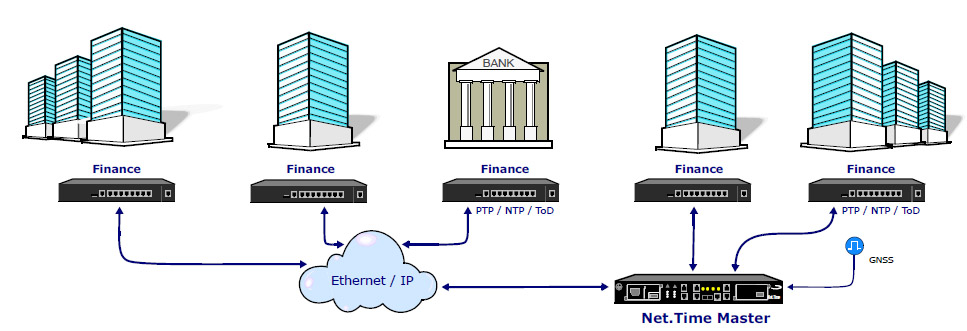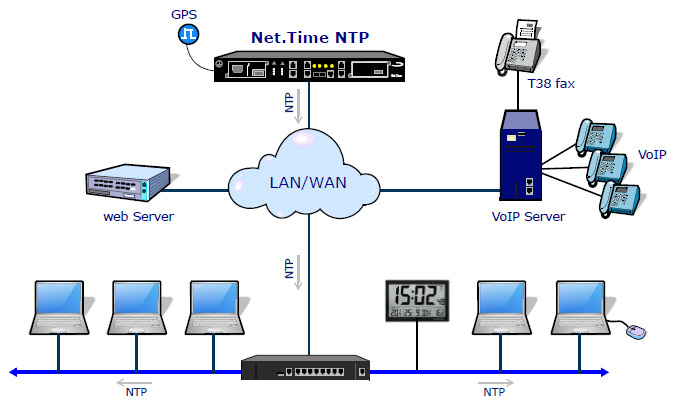Net.Time clock
Net.Time represents the state-of-the-art in timing as it has been designed to deploy the most precise and secure synchronization networks for critical services such as electricity and telecommunications. Net.Time is fault-tolerant, has a built-in GNSS receiver, Rubidium oscillator, redundant power supply and accepts a wide variety of time references that can be used as primary or backup references. Provides compatibility between timing signals for synchronization distribution using protocol translation in all directions.

Net.Time is a PTP / NTP appliance that can be configured as Master, Boundary and Slave clock to distribute a large variety of timing signals including PTP, NTP, SyncE, ToD, IRIG-B, PPS, T1, E1 and MHz. Net.Time is equipped with an atomic Rubidium oscillator to satisfy the highest time accuracy in the event of hold-over, OCXO is also a valuable option to maintain an excellent time stability in locked mode. Net.Time is very flexible indeed, as it accepts multiple clock references to discipline the internal circuits. GNSS is the default and the most obvious reference but signals such as PTP, NTP, SyncE, ToD and IRIG-B can also be used as main reference inputs and can be activated in a hierarchical way.

Net.Time is conceived as a new-generation clock intended to facilitate the transition from to the new PTP networks. With this purpose in mind Net.Time offers seamless translation between SNTP and PTP presenting a wide variety of inputs / outputs for primary or backup time references.
- PTP /NTP over PRP clock for mission critical applications
- PRP native (DAN-P clock) no Red box required
- Supports and translates PTP Telecom and Power profiles to integrate heterogenius networks.
- OCXO / Rubidium are available for internal oscillator.
- Multiple in/out signals PTP, NTP, SyncE, 1PPS, E1, T1, MHz, Mb/s
- PTP-to-all, NTP-to-PTP, IRIG-B-to-PTP protocol translation
- Facilitates the coexistence of legacy and new protocols
Applications
Power Substations
Smart grid automation requires extremely precise time accuracy –and stability as well– for tasks such as peak-hour billing, virtual power generators, or outage management. It is also necessary for the automatic protection of high voltage lines that are permanently supervised, when a substations detects an event, it is timestamped and transmitted to ensure correct operation.

5G Telecom
5G operators require accurate phase and time alignment at the backhaul of the wireless in order to increase the density of terminals reducing cells size. Timing is also necessary for reusing the frequencies, to control the hand-over, logging the events and many more new services that are boosting the mobile business. Net.Time in telecom networks is deployed at the edges and generally configured as a boundary clock to provide a high level of accuracy and protection with signals such as PTP, SyncE, PPS, T1/E1 and MHz.

New wireless deployments have stronger requirements at synchronization plane in order to reduce the size of the cells reusing more often available frequencies and, very important, wireless terminals have to share up/downstream channels to improve the efficiency by using phase information.
Air Traffic Control
Time is a key resource in Navigation Systems to ensure the proper functioning. Inherited signals such as IRIG-B, NTP and TDM are still in use but progressively are being replaced by PTP time-stamping systems to provide a unique, accurate and consistent synchronization based on Net.Time equipped with atomic oscillators disciplined by GNSS and distributed throughout the territory, air traffic control centres and airports.

Finance Institutions

Financial services rely on powerful transport layer capable to provide high speed, availability, security and reliability. At the timing side, NTP and GNSS has been la widely used to synchronize nodes, transactions, and to log time-stamped events in a chronological sequence. Nevertheless today are in the migration pace to PTP that will improve the quality and functionalities of this service.

